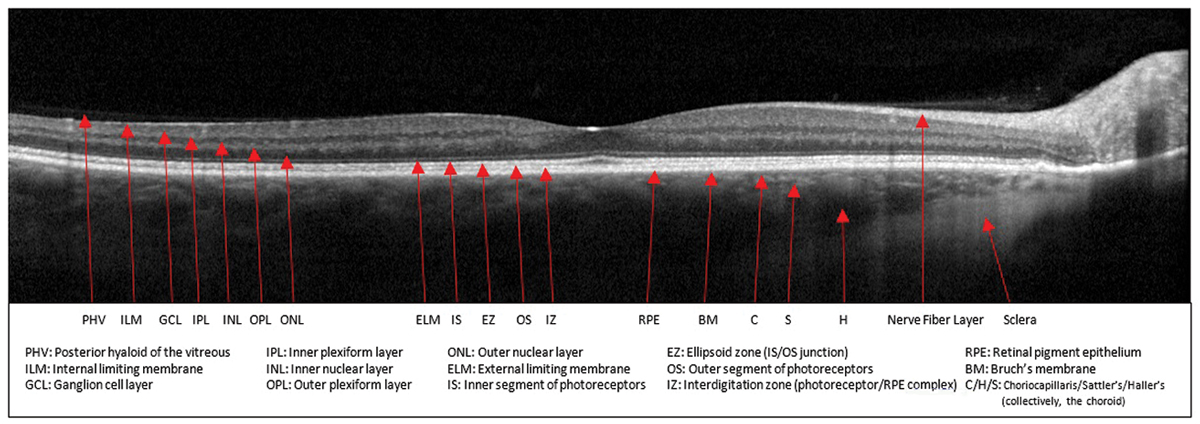 |
| By getting familiar with OCT segmentation of retinal layers, you may be able to identify early warning signs of AMD in at-risk patients. Photo: Sara Weidmayer, OD. Click image to enlarge. |
One of the earliest signs of age-related macular degeneration (AMD) detected on fundus exam is the presence of drusen deposits, which appear in between the retinal pigment epithelium (RPE) and Bruch’s membrane (BM) during adulthood and accumulate over time. However, the timing of drusen buildup and RPE-BM complex thickening in relation to photoreceptor degeneration remains unclear. Through epidemiological analyses across nine segmented layers of the retina, researchers recently identified trends between age and AMD that highlighted the role of photoreceptor thinning, followed by RPE-BM complex thickening, in AMD pathogenesis.
The team jointly analyzed OCT, electronic health record and genomic data of 44,823 individuals (ages 40 to 70, 54% female, median 10-year follow-up) to characterize the time sequence of changes in retinal layer thickness in AMD, as well as epidemiological and genetic associations between retinal layer thickness and AMD.
Photoreceptor segment thinning was observed throughout the lifespan of individuals analyzed, while RPE-BM complex thickening started after age 57. Each standard deviation of photoreceptor segment thinning and RPE-BM complex thickening was associated with incident AMD (hazard ratios: photoreceptor segment=1.35, RPE-BM=1.14).
After analyzing AMD-associated genetic alleles, individually and as a polygenic risk score (PRS), the researchers found that genetic variants increasing the risk of AMD were significantly associated with decreased photoreceptor segment thickness, while a bimodal association was detected with RPE-BM thickness, suggestive of drusen and basal laminar deposit development with AMD PRS over the 90th percentile. Furthermore, locus-specific analyses identified potential mechanistic roles of AMD risk alleles at the genes CFH and ARMS2/HTRA1 on photoreceptor segment thinning and at SYN3/TIMP3 on RPE-BM complex thickening.
“These findings support a potential causal influence of AMD genetic variants on photoreceptor segment thinning and suggest the clinical use of photoreceptor segment thinning as an early-stage biomarker for risk of future AMD development,” the researchers concluded.
Zekavat SM, Sekimitsu S, Ye Y, et al. Photoreceptor layer thinning is an early biomarker for age-related macular degeneration: epidemiological and genetic evidence from UK Biobank optical coherence tomography data. Ophthalmology. February 8, 2022. [Epub ahead of print]. |


